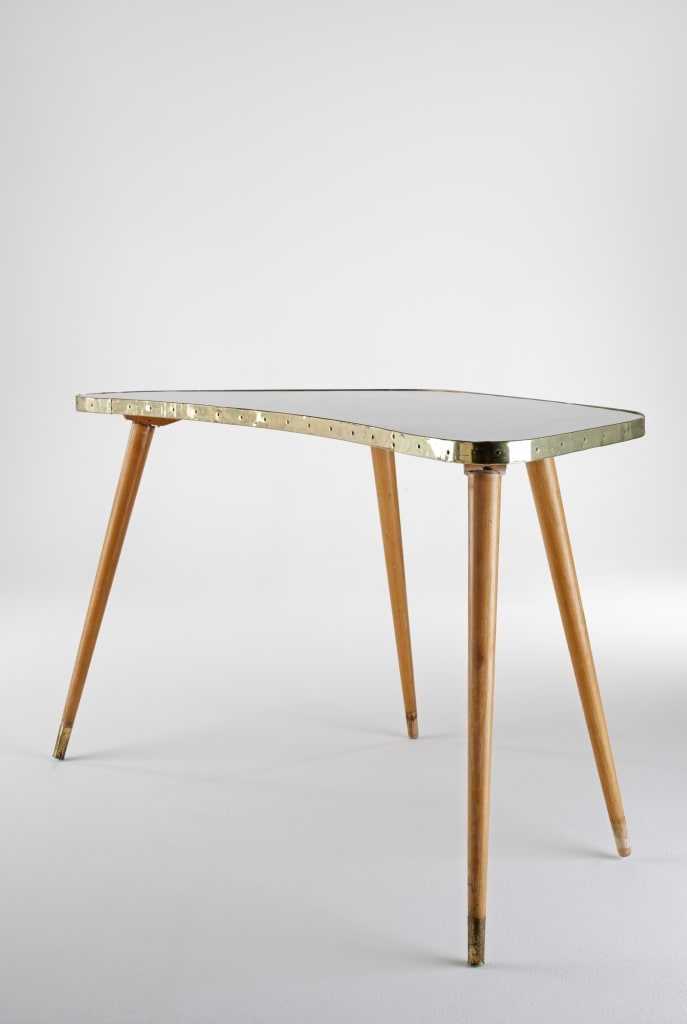July 10, 2024, 3:14 pm | Read time: 4 minutes
In the living rooms of the early Federal Republic of Germany, where more and more televisions flickered, a small, almost inconspicuous piece of furniture became an essential part of the decor. The kidney-shaped table remains popular among interior enthusiasts today, not just for its distinctive shape, as noted by myHOMEBOOK author and interior designer Odett Schumann.
Not long ago, it was trendy to decorate one’s home in a 1950s style–just like the living room of grandparents once looked. This is known as the Midcentury Style. Over time, however, the relatively long-lasting hype subsided. Only a few relics from that era remain, one of which is the so-called kidney table. Here is its story.
A Table Like a Kidney

How the kidney table got its name is probably self-explanatory: The resemblance to the asymmetrical shape of the organ, which is continuously curved and somewhat reminiscent of a kidney bean, is undeniable. Sometimes the appearance leans more towards a crescent, while at other times it resembles a triangle.
Consciously, protruding corners and edges were avoided, even though these are typically characteristic of a table. Instead, they were often rounded off, as was the case with the kidney table. It was also typical to give the iconic piece of furniture a colorful lacquer finish or a mosaic pattern made of colorful stones.
Usually, the small table stood on three, rarely four legs, which were not straight as usual but strikingly angled. This made the furniture of that time stand out significantly from the previous, more rigid designs. For the construction, materials such as aluminum, wood, glass, or plastic were predominantly used.
From Rigid Systems to Soft Forms
What immediately stands out about the kidney table is the absence of any sharp corners and edges. This was not without reason but actually dates back to the Nazi era. During that time, strict and rigid forms primarily dominated the arts.
With the 1950s (and into the 1970s), as people slowly recovered from the war years and gradually returned to some prosperity, they wanted to redecorate. And quite differently from before, when the proverbial parlor was crammed with dark, heavy furniture.
Now, the living room was to appear brighter, friendlier, and lighter. Therefore, in furniture design, softer forms were preferred. It could also be more colorful, which is why kidney tables were often adorned with a mosaic pattern or a colorful lacquer finish.
Also interesting: 6 classic pieces of furniture that always make a home tastefully furnished
When the Family Gathers Around the Coffee Table
With the advent of television in the early 1950s, families increasingly gathered in the living room. They assembled on the couch set around the coffee table. And to place drinks, snacks, or the remote control, a small table fit well into this ensemble. Specifically, one that was at the same height as the sofa. Thus, the kidney table gradually became socially acceptable.
The cocktail chair occasionally joined the setup. Sometimes it even got its own kidney table, so the person in this seat also had a small surface available. With this then-advanced style of furnishing, a new era of living began in the post-war period–some even speak of the kidney table era.
Tubed televisions are now considered outdated, TV cabinets are no longer available, and complete couch sets, as they were once chic, are no longer in demand. Yet the kidney table has endured over the decades and still enjoys great popularity–it is now considered a cult object.

Model Stefanie Giesinger Shows Off Her Apartment in Colorful ‘Space Age’ Style

How to Properly Showcase Modern Tile Furniture

The Trends from IMM Cologne 2024
There Is Still a High Demand for the Kidney Table
The kidney table is still often placed as a practical surface next to a cozy seating area like the couch or armchair. Sometimes, however, this iconic piece of furniture also serves as a kind of plant stand or the perfect spot for cherished keepsakes, travel souvenirs, and decorative objects.
Those who want an original table will most likely find one in an antique shop or at flea and vintage markets. Some people are also satisfied with a reproduction in a retro look from the furniture store. And if price is no object, one can invest in a modern version. More and more design labels are reissuing the kidney table and bringing contemporary versions to the market.


